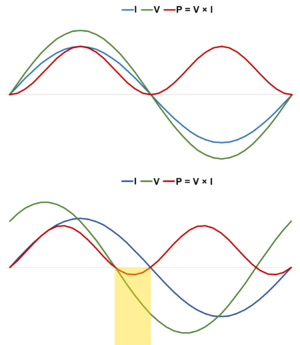Power factor
There are various alternating current (AC) load types, some of which require voltage and current at the same time (resistive loads) and others that require voltage and current at different times (inductive and capacitive). Power factor (PF) is a number between -1 and 1 that can be applied to AC loads to describe to what degree their voltage and current demand (phases) are in sync. A load with a power factor of 1 (top graph at right) will have voltage and current peak simultaneously each cycle. A load with a power factor of less than 1 (bottom graph at right) will have voltage and current peak at different times each cycle.
The power factor of loads becomes important when sizing and selecting an off-grid inverter. A load with a power factor of less than 1 will require that the inverter supply current that exceeds the power rating of the appliance in order for it to work properly. This current is not included in the power rating of the appliance as it is not consumed by the load and is returned to the source. Power factor is therefore only factored into sizing the inverter, but is not relevant when sizing the PV source or energy storage system.
Contents
Calculating power factor
There are different types of power that are used to determine the power factor for a load.
Power factor (PF) = Real power ÷ Apparent power
- Real power is power that is used to perform work. This power is consumed and is measured in watts (W).
- Reactive power is power that is power that does not perform work but is still present in a circuit. This power returns to the source and is measured in volt-amperes or volt-amps (VA).
- Apparent power is the total power present in a circuit. Apparent power is the sum of real power and reactive power. Measured in volt-amperes or volt-amps (VA).
If the current and voltage of a circuit are measured for a circuit with a multimeter and multiplied this will be a measurement of apparent power. Devices specifically designed to measure power consumption, like a Kill-A-Watt meter, can measure real power.
Examples of different load types
Common resistive loads are incandescent light bulbs or an electric heater. These loads will have a power factor of 1, which is also referred to as unity power factor.
- Example 1: A 40 W incandescent bulb is operating on a 120V AC circuit. You measure the current and get .3 A. What is the power factor for this light bulb?
- Power factor = 40 W ÷ (120 V × .3 A) = 1
- All power is consumed by the load.
Common inductive and capacitive loads are fans, televisions, radios, laptops, blenders, refrigerators, and LED lighting. These loads will have a power factor less than 1.
- Example 2: A 20 W laptop is operating on a 120 V AC circuit. You measure the current and get .3 A. What is the power factor for this laptop?
- Power factor = 20 W ÷ (120 V × .3 A) = .5
- 20 W is consumed by the load. The rest is reactive power that returns to the source.
Power factor estimates
Power factor values vary significantly between makes and models of appliances and it can be quite difficult to find specific values. The values in the chart below are conservative estimates.
| Load | Estimated power factor |
|---|---|
| LED bulb | .45 |
| Radio | .9 |
| Cell phone charger | .45 |
| LED TV | .55 |
| Laptop charger | .5 |
| Refrigerator | .5 |
| Blender | .8 |
| Printer - idle | .4 |
| Printer - printing | .65 |
| Electric water heater | .97 |
| Fan | .87 |
| Microwave | .9 |
| Projector | .9 |
Notes/references
- Power Studies: Power Factor — The Basics https://www.powerstudies.com/sites/www.powerstudies.com/files/Power%20Factor%20Basics%20Article.pdf
- American Council for an Energy Efficient Economy - Power Factor Requirements for Electronic Loads in California https://www.aceee.org/files/proceedings/2014/data/papers/9-959.pdf
- Ali Ahmadab, Syed Abdul Rahman Kashif, Muhammad Asghar Saqibb, Arslan Ashrafa, Umar Tabrez Shamib. Tariff for reactive energy consumption in household appliances from Energy Volume 186, 1 November 2019, 115818
